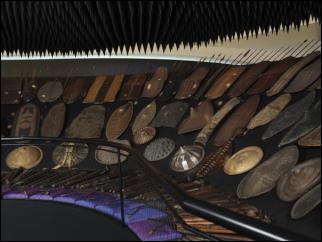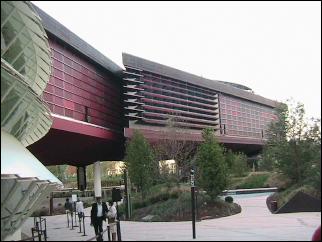France: How One Looked at the Other
How One Looked at the Other
Exhibition
Review by Yasmine RyanJust down
the road from the Eiffel Tower, a significant exhibition
with a strong focus on the Pacific, including New Zealand,
opened last Monday. Titled Regarding the Other, it is
the first major exhibition in Paris’ new Musée du Quai
Branly. Amongst the 1400 objects featured are an impressive
hei-tiki, paintings, and other taonga from Captain James
Cook’s voyages in our corner of the world. Curated under
the direction of Yves Le Fur, this exhibition focuses on the
multi-faceted ways that Europe has represented the
indigenous worlds of the Americas, Africa and Oceania. Many
cultures there were ‘discovered’ via the sea from the
15th century onwards; or, in the case of Oceania, from the
late 18th century. Thus there is a strong navigational and
explorational flavour to the exhibition. Given that the
exhibition spans a five century period, Le Fur has chosen to
divide the immense display along five broad themes: The
World Theatre (1500-1760), The Natural History of the
World (1760-1800), The World’s Big Herbarium
(1800-1850), The Science of People (1850-1920,) and
The Aesthetic Mutation (1900-2006). However, the
viewer is allowed considerable freedom in interpreting the
varied ways Europeans have tried to make sense of ‘the
primitive’: from fantastical monsters to crazed cannibals;
from the noble savage to the racially inferior; from
conquered remnants to free nomads. Some ideas have been
contradictory and absurd; some had their day and then
disappeared; some have been re-born in different forms, in
different places, in different epochs.
These diverse ways
of looking at ‘the Other’ are reflected in the range of
items on display. Particular things were sought at
different times, from the ivory and coconut objects
treasured by European aristocrats in the early 18th century,
to the tribal carvings that inspired early twentieth century
artists like Picasso and Gauguin. Also in the exhibition
are paintings by earlier European artists, such as the rich
portraits by the Dutch painter Albert Eckhout and William
Hodges’ visions of the Pacific. Similarly, an array of
ethnological photographs and anthropological busts reflect
the desire to catalogue other peoples, while an installation
of spears and shields suggests colonial conquest and –
perhaps – indigenous resistance. Whether curious, contemptuous, disgusted or
idealised, what all these reflections on the non-European
other have in common is that they reveal as much about what
and how Europeans think about themselves than they do about
the represented ‘primitive’ cultures themselves. In
stepping back to look at the biases behind this
‘regard’, Le Fur also is confronting a problematic that,
arguably, is intrinsic to the whole Musée du Quai Branly
project. Since its inception, there has been much
controversy surrounding this institution, especially given
its incorporation of the two major French museum
collections, of the Musée de l’Homme and of the Musée
des Arts d'Afrique et d'Océanie, that were an outcome of
that country’s colonial endeavours. Not everything on display reflects
this particular heritage. For example, there are
photographic works by Fiona Pardington and Michael
Parekowhai in the garden area, all gifted by the New Zealand
Government to the Museum to mark its opening last
year. The bulk of the items exhibited in Regarding the
Other are from the museum’s own collection or from
other European museums. They are the spoils of five hundred
years of European interest in non-European peoples and
cultures, and these objects and the narratives constructed
around them are part of a sometimes wonderful and often
tragic, but very much entangled, history that links the
modern West and the tribal non-West. Tackling these
important issues head-on is a good, and undoubtedly
necessary, first step for the Musée du Quai Branly.
ENDS
Image by Patrick
Gries
Image by Patrick
Gries
Musée du Quai Branly, image by
Yasmine Ryan


 Little Miracles Trust: The Little Miracles Trust World Prematurity Day Campaign
Little Miracles Trust: The Little Miracles Trust World Prematurity Day Campaign NZ Society for the Study of Diabetes: Critical Workforce Shortages Leave People With Type 1 Diabetes Unable To Access Life Changing Technology
NZ Society for the Study of Diabetes: Critical Workforce Shortages Leave People With Type 1 Diabetes Unable To Access Life Changing Technology Kindergartens Aotearoa: Kindergartens Aotearoa Opposes Lower Standards For Homebased Services
Kindergartens Aotearoa: Kindergartens Aotearoa Opposes Lower Standards For Homebased Services Universities New Zealand - Te Pokai Tara: Three Outstanding Aotearoa New Zealand Students Awarded Rhodes Scholarships
Universities New Zealand - Te Pokai Tara: Three Outstanding Aotearoa New Zealand Students Awarded Rhodes Scholarships University of Auckland: 800 Mathematicians Set To Converge On Auckland
University of Auckland: 800 Mathematicians Set To Converge On Auckland NZEI Te Riu Roa: NZEI Te Riu Roa Joins Calls To Restore Cut To Pasifika Early Literacy Project
NZEI Te Riu Roa: NZEI Te Riu Roa Joins Calls To Restore Cut To Pasifika Early Literacy Project